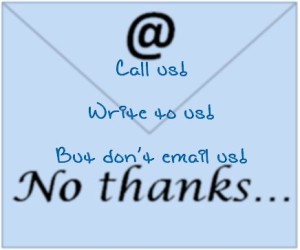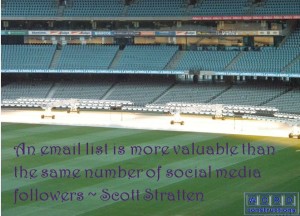I hope you find my writing and business tips and observations useful. My business and blog are dedicated to helping businesses communicate clearly and reach their potential.
Read, subscribe to my newsletter, enjoy!Tash
Managing and turning off new tools like online chat
We need down time, even from our favourite things.

Like a young child playing with new toys, we all like to play with our new tools and gadgets. Are we also like young children that we need a rest from our toys/tools?
Having done the research into online chat, I was introducing it to some of my client’s employees the other day.
One of the employees – let’s call him Simon for simplicity – liked the idea of offering it to their customers but asked some really good questions.
Won’t we need a dedicated person to manage the online chat? None of us have time to take that on.
What happens if the online chat person is on the phone or something when someone wants to chat?
Managing a new feature
There’s no doubt that adding a new feature or tool can create extra work in the short-term. It takes time to set up and learn how to use it, and you may have to explain it to a number of people before it becomes fully effective.
I don’t think adding online chat means getting an extra person into the workplace. Even in a busy customer service business, the online chat should reduce the number of phone calls and emails which would free up the time needed to answer chats.
For Simon, I was able to explain that a little pop up window will show to all relevant staff when someone wanted to chat so any available staff member could answer.
Ability to turn the feature off
Another reassurance for Simon and his team was that online chat doesn’t have to be on all the time.
While there are variations between online chat systems, my client will have a choice between making the chat feature invisible or showing as offline to collect an email address when staff are unable to accept chats.
I think that’s important.
So many great new tools are offered to businesses but we need down time – to do our work, to undergoing training, to have a break and so on. Whether it is joining social media, online chat, a eShop or other tool, we need to be able to turn it off in some way.
How often do you turn off social media, emails and similar communication tools?
What if you had online chat on your site – would you turn it to offline even if you are physically present? Turn it off out of business hours, even if you can use it while mobile?
* Image courtesy of 123RFA new online chat option

Deciding to add live chat to your website is just step one – deciding on a supplier can be time-consuming. Reviews of suppliers can aid your search…
Since writing my review of online chat options last month (was it really that long ago?), I’ve done more testing and refining. And then another option caught my eye, despite having stopped looking, and I’m really impressed with it so I’m adding this to the list…
- They are based in Melbourne and I like dealing with and supporting Australian businesses when I can
- 15 day free trial – again, I like the fact no credit card details are required in advance
- Can access via smart phones and tablets – needs a Google talk based widget
- Clean, attractive website – doesn’t affect the use of the tool obviously but does inspire more confidence than the Live Help Now site
- Prices based on business size – $0 (1 operator and 10 chats per month) to $36 a month (8 operators, united chats)
- Can also pay for monitored chats – they’ll answer queries for you! Appealing but obviously costs more
- Chat transcripts stored for 30 days
- Can apparently install in less than 30 seconds – it is easy to install but if you don’t have an instant messaging account you also need time to set that up (and it’s worth noting that Google has just changed their chat to hangouts)
- Can customise the chat window messages – but not the colours or branding unfortunately. However, that feature is coming in about 2 months and they’ll help clients one-on-one as required.
- Form to collect contact details when you’re offline
- Includes an installation guide on their website – and it is in Plain English, not tech speak
- Requires a third party instant message client such as Google Talk, Pidgin or eBuddy
- Chat window stays constant even as someone moves pages on your site
- Chat window pops up after someone is on your site for 10 seconds but will not reappear once they close the window. Easy to close/ignore/minimise/respond once the window pops up
- You can add it to as many websites as you wish
- It is supposed to work with all major browsers
- No contracts, just pay month to month via credit card – paypal option coming soon
- Maintain a regular presence on Twitter – reassuring to see they are active and current as their blog is a bit light on
- I received friendly support via their online chat and a follow-up phone call where they asked what features I want. My IT support also got follow-up support very quickly after he asked for help in their chat.
** Unlike the other options I reviewed, assistro not only has an affiliate program but is also worth mentioning via that affiliate program s0 the links to their site may result in an affiliate payment to me if you choose their paid service – it won’t cost anything extra for you either way.
Hiding email addresses leaves a sour taste
Do you think email addresses should be hidden or open to your clients or members?

A business making it hard for customers to email them just doesn’t make much business sense to me. Yet that’s exactly what one organisation is doing to their members…
Today, I received an email from an organisation I’m a member of. {Disclaimer – I am only a member there because I haven’t made the time to move elsewhere – that time is now a high priority.}
Replying to emails
I did not like today’s email – I mean it was laid out ok and was polite and appropriate as far as the wording went, but I am not happy with the content. Largely because it showed that organisation is using member money to fund something completely unrelated, public and providing no obvious benefit to members.
I hit reply to tell them what I think. I doubt my voice will make a huge difference but I would feel better to be honest about it.
However, the email comes from a no-reply address.
Instead, I went to their website to grab their email address to use instead, but they only have an online form. So I even went as far as checking some letters they’ve sent me in the past – also the contact form URL instead of an email address.
So I can’t reply to the email.
And I am left feeling they are hiding from members. Feeling they are hiding from complaints. Feeling a bit uncomfortable and like I’ve touched something dirty with the way they are keeping contact details secret.
Selective email address use
Spam is awful – I hate it. So like many others I avoid putting my email address online in a way that spam bots can find it.
Yet that doesn’t mean my email address is hidden completely.
It is on my business cards, letterhead and certainly is the ‘reply to’ address for my html newsletter.
Other organisations put their email address on their site as a graphic – bots being unable to read graphics (well, so far anyway!) – or in words (eg write AT wordconstructionsDOTcomDOTau is an acceptable way for me to share my email address online.)
And it’s not like I’m talking about a small organisation that can’t cope with emails – a sole trader or other SMB may need to manage contact options, but a big business has more staff and even dedicated staff for customer service.
Is limited promotion the same as hiding?
What do you think?
Are they protecting themselves from spam or from complaints? Are they hiding their email address, even from members, or is it a reasonable business decision?
And I’d love to hear what you have done to promote or hide your email address, too.
Finding the obvious may lead to jobs…
What opportunities are you missing by taking things for granted?
I am not an expert in Microsoft Excel but I can use it competently and am aware of its capabilities even when I don’t use some features.

This simple graph was produced from a table of data in excel for one of my clients. For me, it was an obvious way to produce a graph; for my client, it was a major challenge to know how to produce it at all.
And it hadn’t occurred to me that someone who uses Excel for various tasks wouldn’t know that you can easily create graphs from the data entered into Excel. It’s just obvious to me so I took it for granted that it was obvious to others.
Yet, that isn’t the case.
Graphs in Excel – not so obvious to everyone
A couple of weeks ago I did a presentation which included a simple graph on one slide. Afterwards, I was talking with a client and he mentioned wanting some graphs for a report he was working on.
Long story short, he didn’t know excel would do that for him.
I set up that simple graph for him and now am managing a larger excel-based project for him. I say managing because it is a more complex graph so I have outsourced it to someone I know who is an Excel expert!
Missed opportunities
It has me thinking though. How many more graphs could my client have used, in reports or presentations or for his own use, if I had told him about excel graphs sooner?
How many clients could I have referred to my excel expert?
When we know something, it’s hard to remember that many others don’t know it or at least know it as well as well as we do.
Are there some obvious tasks or skills you aren’t seeing for your business?
I wonder what great opportunities you could find by spotting those obvious tasks and skills…
One coin, two sides; One budget, two perspectives
There are always two sides to a coin, two side to a story and two perspectives to view things by.
On Tuesday, the Federal Budget was announced.
I’ve read quite a few summaries of the Budget so I can write updates for clients. Some are better than others, of course.
Perspectives of the Federal Budget
However, my point relates to how small business is impacted by this Budget. Noting that small business got very little direct mention by the Government in this budget.
A number of business groups have released their view that Government ignored this significant sector of our economy. As advocates of this diverse group, they are annoyed because small business don’t appear to have been included.
Yet another business group or two has put out the view that small business was lucky to have avoided the attention big business got in the Budget. I for one am glad we don’t have to report PAYG each month, for instance.
Both views are based on the same fact (little mention of small business) but are looking at it in different ways. I found that very interesting.
Are you communicating your business direction?
A few days ago I posted about the employee engagement survey conducted by AIM. And how poor many rank communications within their workplace.
One tool to improve employee engagement is to clearly communicate your mission and value to your employees – this same survey showed that is significant. Presumably because people can feel where the business is heading and thus find ways to contribute to that direction.

A mission and vlaues statement is about answering basic questions on the business direction and aspirations.
Value of a mission and vision
64% of the AIM respondents said their organisation gets a positive return from having a mission and value statement.
I admit that I am one of those who think a mission and values can be a waste of time. But apparently they can be done well enough to inspire many employees.
I like the fact that, of those aware of their employer’s mission, 64% believe those values are reflected in their operations. Part of my cynicism is that a mission is just words on a page unless taken seriously – it appears many businesses are taking them seriously.
The survey summary states that employees being aware of a business’s missions and values…
- more than doubles the belief in management cultivating a good organisational culture
- increases employee loyalty (by a factor of 1.5)
- makes it less likely they will change employers
- makes it more likely to care about the future of the business
Use of a vision and mission statement
Further break down of the survey results shows that micro-businesses (ie have 20 or fewer employees) are less likely to have given employees a clear mission or values.
Of course, micro-businesses may have closer relationships within the business (the owner of CEO is more likely to be involved with all staff if there are only a dozen or so of them!) so a written statement may seem less necessary.
However, it if has benefits and makes it clear for new employees, and reminds existing employees, maybe a written statement is worthwhile for micro-businesses, too.
Does your business have a written mission and values statement? If so, how public is it – who knows about it?
Are you communicating well within your business?
Maybe you are, but a recent survey from the Australian Institute of Management (AIM) has shown that only 39% of respondents classed two-way communication between management levels as ‘effective’ or ‘very effective’.
Of course, that means 61% consider it moderately effective or worse. That’s a big number.
Note for micro-businesses (with 20 or fewer staff) 59% rated it effective or very effective while 50% gave that rating if staff levels between 21 and 50 applied. Staff rate this effectiveness less as the business size grows, which makes a certain amount of sense.

Communicating effectively is the only way to get your idas across to others – and to get them to help you implement your ideas.
Communications is important
On a positive note, the survey showed many people will stay in their current job because they have a great relationship with co-workers.
So the question is, how do businesses improve communications within teams and from the leadership to everyone else?
I think the key is wanting to communicate – the hows and skills can only do so much if management wants to keep secrets and power to themselves.
Improve communications ideas
From the survey itself, some ways to improve that perception of two-way communications include:
- 57 % believe management listens and responds to employee concerns – so actively listening is a clear method for making improvements
- 59% stated that being valued and understood is a major factor in employee engagement – that comes back to listening and ensuring communication really is two-way
- 55% agree and 43% strongly agree that is it important to be acknowledged for their work – communicating appreciation of people’s efforts and skills could make a huge difference in their happiness and loyalty. Yet only 54% felt appreciated by their employer…
Taking breaks makes you more productive, less overwhelmed
How often do you feel overwhelmed with things?
How often do you feel quiet – no tweets, emails or status updates firing at, no phone calls or client/boss requests, no attempts at reducing a to do list?
As I mentioned a few days ago, I heard a webinar in which Matthew May spoke about his book, The Laws of Subtraction (6 simple rules for winning in the age of excess everything).
I intend reading this book, and will review it in this blog, as I am very conscious of how much stuff business people have to deal with. We’ve always had to deal with multiple roles (accounts, marketing, sales, staffing, production, etc) but now we have digital presence and technical changes to keep up with as well.
I am also thinking of reading one of his other books, The Shibumi Strategy (A Powerful Way to Create Meaningful Change). It sounds interesting and apparently is written as a story rather than in typical business book mode.
Taking and making breaks
Matthew’s fifth law is ‘break is the important part of breakthrough’ and I think that will be a very interesting chapter. I think breakthroughs can change lives – whether it is a breakthrough new product that changes the world or a simpler breakthrough on a better way to deal with a difficult client or finding a new tool that will save you time.
Any break from routine/habit/patterns can make us look around, take notice and see the things we take for granted most of the time. Then we can be more creative and find solutions or new ideas.
I like the idea of regularly getting away from my desk – and by regularly I mean once an hour or so – but I admit I often get caught up in things and stay working for longer than I probably should.
So I want to ask how you fit breaks into your working day/week. Is it something you plan or do you ‘go with the flow’?
What do you do in your breaks?
Limiting information engages imgaination
Today I heard a webinar based on the book The Laws of Subtraction (6 simple rules for winning in the age of excess everything). Matthew E May, author of the book was interviewed by Suzi Dafnis of ABN.
His third law hits a similar theme to what I often write so I wanted to share it.
Law #3: Limiting information engages the imagination
This law is commonly stated as the cliché ‘less is more’ and writers are often told to ‘show not tell’ for more powerful writing.
Giving all the facts leads to overload and disinterests people so I suggest writing as little as possible to suit the message.
But I like Matthew’s twist – I believe it is true that too much information stifles imagination. Giving enough information to set a foundation is enough.
What information can you limit to get people’s imagination working in your favour?
Matthew gave the example of Steve Jobs launching the first iPhone – he showed one, explained some of what it could do and then said no more until it launched a few months later. And something like 20 million people signed up to buy one before it was on sale. That’s a lot of people acting on limited information, isn’t it?
* Image from Word Constructions





Recent Comments